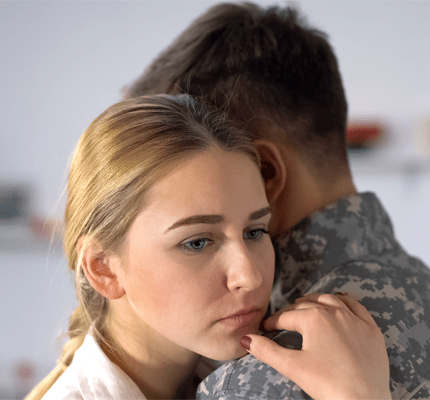
How Military Couples’ Affectionate Communication Changes as They Adjust to Post-Deployment Life
Military deployment can strain couples’ relationships. However, returning from deployment can also pose challenges. During the post-deployment period, couples may experience intense feelings, both positive and negative; they may be happy to be re-united, but also face difficulties because of personality changes or other struggles as they resume daily life. In a new article published in NCA’s Communication Monographs, Leanne K. Knobloch, Lynne M. Knobloch-Fedders, Jeremy B. Yorgason, Erin C. Wehrman, and J. Kale Monk use relational turbulence theory to examine how turbulence affects couples’ affectionate communication during the post-deployment period.
Relational Turbulence Theory
The relational turbulence model addresses why periods of transition can disrupt communication within relationships. According to the model, during periods of transition, people may react strongly to specific relationship episodes or events because of relational uncertainty. During these transitional periods, routines may also be interrupted, which researchers refer to as interference and facilitation from partners.
The relational turbulence theory builds on the model to examine how turbulence affects communication during transitional periods more broadly. According to the theory, reactions to individual episodes add up, creating a sense of turbulence within the relationship and affecting communication. Relational turbulence can impede effective communication. In this study, Knobloch, Knobloch-Fedders, Yorgason, Wehrman, and Monk examine the degree to which relational turbulence increases among post-deployment couples as they re-adjust to daily life.
Affectionate Communication
Affectionate communication is important for relationship maintenance and provides benefits to physical and mental health. Affectionate communication can include verbal expressions of affection (e.g., “I love you”), as well as nonverbal expressions of affection (e.g., hugging, kissing, or holding hands). Affectionate communication can help couples navigate the post-deployment transition, but it also may decrease over time as couples adjust to normal routines. In addition, as relational turbulence increases, affectionate communication may decrease. In this study, Knobloch and colleagues also examine the relationship between relational turbulence and affectionate communication.
The Study
The authors surveyed 268 post-deployment military couples. Each partner filled out an online survey each month for eight months following the return from deployment. The surveys assessed the couples’ relationship satisfaction, depressive symptoms, relational turbulence, and affectionate communication, as well as whether the individual who was deployed had been exposed to combat. Most of the couples were married, cohabitating, mixed-sex couples. For 98 percent of the couples surveyed, the returning service member was male, and the at-home partner was female. The average length of deployment was nearly eight months, and most (71 percent) had previous deployment experience.
Results
The survey results showed that relational turbulence increased over time. As couples moved out of the “honeymoon” phase and adjusted to post-deployment life, they experienced more stress in their relationship. And, as relational turbulence increased, affectionate communication decreased. Knobloch and colleagues suggest these results might be analogous to the decrease in affection experienced by newlywed couples during the early years of marriage, known as the disillusionment model, which suggests that couples’ affection decreases because their relationship fails to live up to expectations. In general, however, the couples reported low levels of relational turbulence and were able to effectively reintegrate following deployment. The authors argue that this is consistent with other data showing “that most returning service members and at-home partners cope effectively with the demands of reintegration.”






